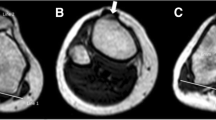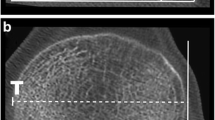Abstract
Purpose
Medial transfer of the tibial tubercle has become a standard procedure in cases of patella instability caused by an increased tuberositas tibae-trochlear groove (TT-TG) distance. However, the TT-TG distance has always been assessed as an absolute value without taking individual joint size into consideration. It was assumed that the pathological influence of the TT-TG distance correlates with individual joint size. Aim of the current study therefore was to develop a method to express TT-TG distance in relation to these joint variables.
Methods
Two hundred knee MRI scans of healthy individuals (69 females and 131 males) were evaluated retrospectively in a control group. First, the TT-TG distance was measured as described by Schoettle et al. To determine joint size, the proximal–distal distance between the entrance of the chondral trochlear groove (TE) and the onset of the patella tendon at the tibial tubercle (TT) was selected. Subsequently, the TT-TG/TT-TE ratio expresses the relationship between the TT-TG distance and the proximal–distal distance from the entrance of the chondral trochlear groove to the height of the tibial tubercle. The TT-TG Index can also be expressed as an angle (TT-TG angle). Likewise, in another patient group, 54 knee MRTs of patients with patellofemoral instability were evaluated.
Results
The average TT-TG distance of the control group was 7.5 ± 3.5 mm (range 0–17.4 mm) with no significant differences between genders. The mean TT-TE distance was 63.9 mm (range 49–79 mm) with there being significant differences between genders. The resulting mean TT-TG Index was 0.12 ± 0.05 (range 0–0.25). In the patient group, the average TT-TG distance was 13.5 ± 4.1 mm and the average TT-TE distance was 61.3 ± 6.8 mm. The resulting average TT-TG Index of 0.22 ± 0.07 in the patient group (PFI) approximates the threshold determined by the 95 % confidence interval in the healthy control group. A direct comparison between the control group and the patient group revealed a significant difference in the TT-TG distance (p = 0.0001), in the TT-TE distance (p < 0.0042) and in the resulting TT-TG Index (p < 0.0001).
Conclusions
The measurement of the TT-TG Index is a reliable and differentiated approach for determining the lateral displacement of the tibial tubercle in relation to the proximal trochlear groove. The pathological influence of the TT-TG distance in case of patella instability depends on individual joint size, confirming the initial hypothesis. We currently consider a TT-TG Index >0.23 to be pathological based on our findings. Particularly, in case of a marginal TT-TG distance, the additional relative TT-TG Index facilitates a decision concerning an indication for a operative medial transfer of the tibial tubercle.
Level of evidence
II.






Similar content being viewed by others
References
Balcarek P, Jung K, Frosch K-H, Stürmer MK (2011) Value of the tibial tuberosity–trochlear groove distance in patellar instability in the young athlete. Am J Sports Med 39(8):1756–1761
Cooney A, Kazi Z, Caplan N, Newby M, Gibson ASC, Kader D (2012) The relationship between quadriceps angle and tibial tuberosity–trochlear groove distance in patients with patellar instability. Knee Surg Sports Traumatol Arthrosc 20(12):2399–2404
Dejour H, Walch G, Nove-Josserand L, Guier C (1994) Factors of patellar instability: an anatomic radiographic study. Knee Surg Sports Traumatol Arthrosc 2(1):19–26
Fithian DC, Paxton EW, Stone ML, Silva P, Davis DK, Elias DA, White LM (2004) Epidemiology and natural history of acute patellar dislocation. Am J Sports Med 32(5):1114–1121
Goutallier D, Bernageau J, Lecudonnec B (1977) The measurement of the tibial tuberosity. Patella groove distanced technique and results (author’s transl). Rev Chir Orthop Reparatrice Appar Mot 64(5):423–428
Koëter S, Diks M, Anderson P, Wymenga A (2007) A modified tibial tubercle osteotomy for patellar maltracking RESULTS AT TWO YEARS. J Bone Joint Surg Br 89(2):180–185
Muneta T, Yamamoto H, Ishibashi T, Asahina S, Furuya K (1994) Computerized tomographic analysis of tibial tubercle position in the painful female patellofemoral joint. Am J Sports Med 22(1):67–71
Nikku R, Nietosvaara Y, Aalto K, Kallio PE (2009) The mechanism of primary patellar dislocation: trauma history of 126 patients. Acta Orthop 80(4):432–434
Schoettle PB, Zanetti M, Seifert B, Pfirrmann CW, Fucentese SF, Romero J (2006) The tibial tuberosity–trochlear groove distance; a comparative study between CT and MRI scanning. Knee 13(1):26–31
Staeubli H, Bosshard C, Porcellini P, Rauschning W (2002) Magnetic resonance imaging for articular cartilage: cartilage-bone mismatch. Clin Sports Med 21(3):417–433
Tecklenburg K, Dejour D, Hoser C, Fink C (2006) Bony and cartilaginous anatomy of the patellofemoral joint. Knee Surg Sports Traumatol Arthrosc 14(3):235–240
Tsujimoto K, Kurosaka M, Yoshiya S, Mizuno K (2000) Radiographic and computed tomographic analysis of the position of the tibial tubercle in recurrent dislocation and subluxation of the patella. Am J Knee Surg 13(2):83
Wang J, Yue B, Wang Y, Yan M, Zang Y (2012) The 3D analysis of the sagittal curvature of the femoral trochlea in the Chinese population. Knee Surg Sports Traumatol Arthrosc 20(5):957–963
Conflict of interest
The authors declare that they have no conflict of interest.
Author information
Authors and Affiliations
Corresponding author
Additional information
Swen Hingelbaum and Raymond Best have contributed equally to this work.
Rights and permissions
About this article
Cite this article
Hingelbaum, S., Best, R., Huth, J. et al. The TT-TG Index: a new knee size adjusted measure method to determine the TT-TG distance. Knee Surg Sports Traumatol Arthrosc 22, 2388–2395 (2014). https://doi.org/10.1007/s00167-014-3204-1
Received:
Accepted:
Published:
Issue Date:
DOI: https://doi.org/10.1007/s00167-014-3204-1




